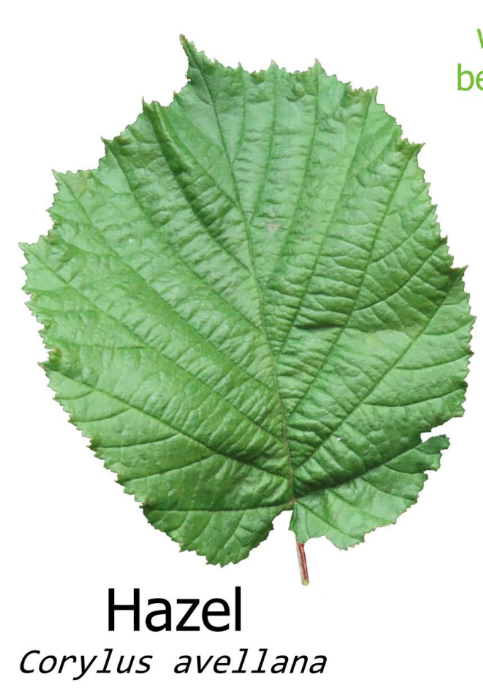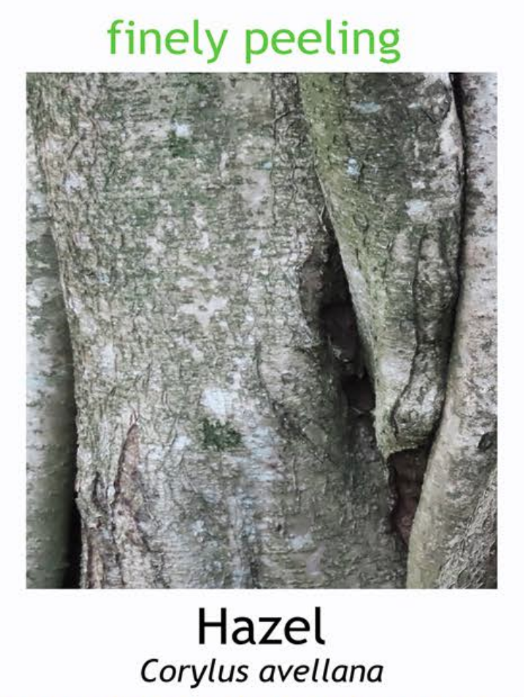A native deciduous tree species in Ireland, commonly found in woodlands, hedgerows, and mixed forests.
Recognising the Hazel Tree:
-
Leaves: The leaves of the Hazel tree are alternate, rounded, and doubly serrated along the margins. They are dark green in colour and turn yellow to golden-brown in autumn before falling.
-
Bark: The bark of the Hazel tree is smooth and greyish-brown when young, becoming rougher and darker with age. It often develops shallow fissures and irregular ridges.
-
Catkins: Hazel trees produce pendulous catkins in late winter to early spring before the leaves emerge. The male catkins are long and yellow, while the female catkins are shorter and greenish.
-
Nuts: After pollination, Hazel trees produce clusters of small, round nuts known as hazelnuts or cobnuts. The nuts are enclosed in a leafy husk and ripen in late summer to early autumn.
-
Habitat: Hazel trees are commonly found in a variety of habitats, including woodlands, hedgerows, and mixed forests. They prefer moist, well-drained soils and are often associated with other broadleaf tree species.



5 Interesting Facts about the Hazel Tree:
-
Ancient Symbolism: The Hazel tree has ancient symbolism and is associated with wisdom, knowledge, and inspiration in Celtic and other folklore traditions. In Irish mythology, the Hazel tree was believed to be the source of knowledge and inspiration for poets and druids.
-
Edible Nuts: Hazel trees produce edible nuts known as hazelnuts or cobnuts, which have been consumed by humans for thousands of years. Hazelnuts are rich in protein, healthy fats, vitamins, and minerals, making them a nutritious and versatile food source.
-
Traditional Uses: Various parts of the Hazel tree, including the wood, nuts, and leaves, have been used in traditional crafts, cuisine, and medicine. The wood is valued for its flexibility and strength and has been used for making tools, furniture, and wattle fencing. The nuts are used in culinary applications such as baking, confectionery, and cooking oil.
-
Wildlife Habitat: Hazel trees provide habitat and food for a variety of wildlife species. Birds feed on the nuts, while insects pollinate the catkins and feed on the foliage. Mammals such as squirrels and mice may also feed on the nuts and use Hazel trees for shelter and nesting sites.
-
Coppicing: Hazel trees have the ability to regenerate vigorously from coppiced stools, making them valuable for sustainable forestry and woodland management. Coppicing involves cutting the tree back to ground level to stimulate new growth, which can be harvested for wood, fuel, or other purposes.
Uses of the Hazel Tree:
-
Edible Nuts: The nuts produced by Hazel trees, known as hazelnuts or cobnuts, are consumed by humans in various culinary applications. Hazelnuts are used in baking, confectionery, cooking oil, and as a nutritious snack. They are rich in protein, healthy fats, vitamins, and minerals, making them a valuable food source.
-
Woodcraft: The wood of Hazel trees is valued for its flexibility, strength, and attractive grain pattern. It is used in traditional crafts such as wattle fencing, hurdles, walking sticks, and basket weaving. Hazel wood is also used for making tools, furniture, and small woodworking projects.
-
Wildlife Habitat: Hazel trees contribute to biodiversity by providing habitat and food for a variety of wildlife species. Their presence enhances habitat complexity and provides food, shelter, and nesting sites for birds, insects, and mammals, contributing to overall biodiversity in woodlands, hedgerows, and mixed forests.
Contribution to Biodiversity:
-
Habitat Provider: Hazel trees create diverse micro-habitats that support a wide range of plant and animal species. Their presence enhances habitat complexity and provides food, shelter, and nesting sites for wildlife, contributing to overall biodiversity in woodlands, hedgerows, and mixed forests.
-
Food Source: The nuts produced by Hazel trees are an important food source for birds, mammals, and insects. Birds such as woodpeckers, jays, and nuthatches feed on the nuts, while mammals such as squirrels, mice, and deer may also browse on the foliage and feed on the nuts.
-
Pollinator Support: The catkins produced by Hazel trees provide an important early-season nectar and pollen source for pollinators such as bees, butterflies, and moths. This supports pollinator populations and contributes to the health of ecosystems.
In summary, the Hazel tree is recognisable by its rounded leaves, pendulous catkins, and clusters of edible nuts. It holds cultural significance,
Images taken from the beautiful posters created by Phil Barnett and you can download these and/or purchase other great designs from his online shop.
